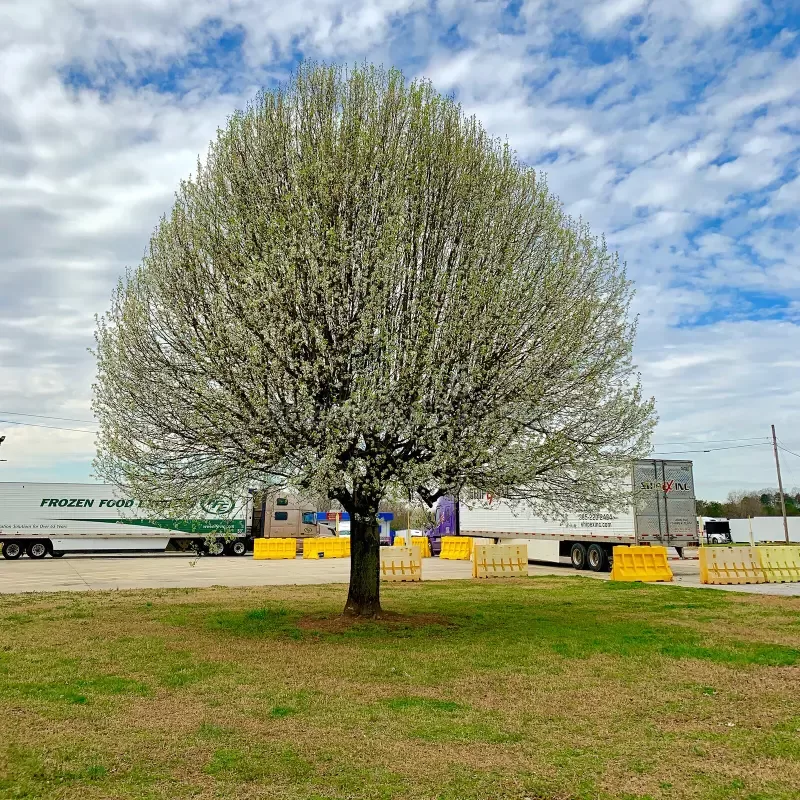If you’re looking to add a unique, elegant touch to your landscape, the Chanticleer pear tree (Pyrus chanticleer pear) is an excellent choice. Known for its compact size, striking features, and low maintenance, this ornamental pear tree has become a popular choice for gardeners, landscapers, and homeowners. Here’s everything you need to know about this beautiful tree, from its characteristics to planting tips.
What is a Chanticleer Pear Tree?
The Chanticleer pear tree (Pyrus chanticleer) is a small to medium-sized ornamental tree native to Asia. It is a cultivar of the Callery pear species and is renowned for its narrow, columnar shape, making it perfect for urban spaces, narrow garden beds, and small yards. This tree is also commonly referred to as the pear Chanticleer tree due to its unique and elegant appearance.
Why Choose a Chanticleer Pear Tree?

1. Attractive Foliage
The Chanticleer pear offers rich, glossy green leaves throughout the growing season. In the fall, these leaves turn vibrant shades of red, orange, and yellow, adding striking color to your garden.
2. Showy White Blossoms
In spring, the Pyrus chanticleer pear blooms with clusters of white flowers that fill the air with a light fragrance. These blooms are not only beautiful but also attract pollinators such as bees.
3. Compact Growth
One of the standout features of the pear Chanticleer tree is its narrow, upright growth habit. This makes it ideal for urban environments where space is limited but the desire for a beautiful tree is still strong.
4. Durability and Low Maintenance
The Chanticleer pear tree is hardy and adaptable to various soil types, making it easy to care for. It’s resistant to many pests and diseases, making it an excellent option for those who want a low-maintenance tree.
5. Year-Round Interest
From its spring flowers to its fall foliage and winter silhouette, the Chanticleer pear adds year-round visual interest to any landscape.
Unique Features of the Chanticleer Pear Tree (Pyrus Chanticleer)
The Chanticleer pear tree (Pyrus chanticleer) stands out among other ornamental trees due to its exceptional characteristics. Here are some unique features that make it a favored choice for landscapes and gardens:
1. Columnar Shape
One of the most unique features of the Chanticleer pear tree is its slender, upright, and columnar shape. This growth habit allows the tree to fit in smaller spaces, making it an ideal option for urban gardens, narrow streets, or tight planting areas where traditional broad-spreading trees might be impractical.
2. Long-Lasting Blooms
In spring, the pear Chanticleer tree produces abundant clusters of small, white flowers that bloom before the leaves emerge. These showy blossoms create a stunning visual display, often lasting for several weeks. Their delicate fragrance also adds an extra layer of sensory appeal to your garden.
3. Brilliant Fall Foliage
Unlike many trees that only offer seasonal color in spring or summer, the Chanticleer pear truly shines in the fall. As temperatures cool, the leaves transform into brilliant shades of red, orange, and yellow, creating a vibrant autumn spectacle that lasts for weeks.
4. Compact Size with Strong Vertical Growth
While the Chanticleer pear tree doesn’t grow wide, it grows tall, reaching a height of 20 to 30 feet with a spread of just 10 to 15 feet. This makes it an excellent choice for creating a vertical accent in gardens with limited horizontal space.
5. Disease and Pest Resistance
The Pyrus chanticleer pear is well-known for its resistance to many common pear diseases, including fire blight, which can affect other pear varieties. Its natural resistance to pests and diseases makes it a low-maintenance and trouble-free tree to grow.
6. No Fruit Mess
Unlike many other pear trees, the Chanticleer pear tree produces minimal fruit, and what it does produce is often too small to be noticeable. This means less mess from fallen fruit, making it a cleaner choice for areas where fruit drop might be an issue.
7. Tolerance to Urban Conditions
The Chanticleer pear is well-suited to withstand urban conditions such as pollution, compacted soil, and limited space. Its adaptability to a range of environments makes it a great option for city streets, parks, and commercial landscapes.
8. Drought Tolerance
Once established, the pear Chanticleer tree demonstrates impressive drought tolerance. It can withstand periods of dry weather without requiring constant watering, making it a great option for areas with low rainfall or water restrictions.
9. Attracts Pollinators
The white spring flowers of the Chanticleer tree are not only beautiful but also attract bees and other pollinators to your garden. This makes the tree a beneficial addition to any eco-friendly landscape, helping to support local pollinator populations.
10. Winter Interest
Even in winter, the Chanticleer pear tree has an attractive presence. Its bare branches form an elegant, architectural silhouette against the sky, creating visual interest throughout the colder months when many other trees are dormant.
Planting and Care Tips for Pyrus Chanticleer Pear
1. Sunlight
The Chanticleer pear tree thrives in full sun. Plant it in a location that receives at least 6 hours of direct sunlight per day for the best growth and flowering.
2. Soil
This tree is adaptable to a variety of soil, including sandy, loamy, and clay. However, it prefers well-drained soil to prevent root rot.
3. Watering
While the pear Chanticleer tree is drought-tolerant once established, it’s important to water it regularly during its early years. Water deeply but infrequently to encourage deep root growth.
4. Pruning
Minimal pruning is needed for this tree. However, to maintain its columnar shape, remove any crossing or broken branches. The best time to prune is in late winter or early spring before new growth begins.
Conclusion
The Chanticleer pear tree (Pyrus chanticleer) is a wonderful addition to any garden or landscape. With its beautiful spring blooms, vibrant fall colors, and compact, upright shape, the pear Chanticleer tree is perfect for small spaces or as a striking focal point in larger landscapes. Whether you’re adding it to a residential yard or an urban garden, this tree offers beauty and durability that will last for years to come.
When considering adding this remarkable tree to your landscape, look for Chanticleer pear trees at your local nursery or garden center, and enjoy its beauty season after season.





